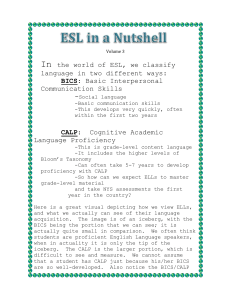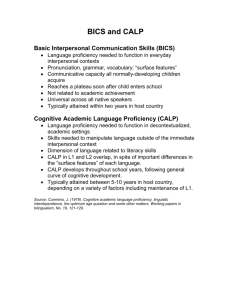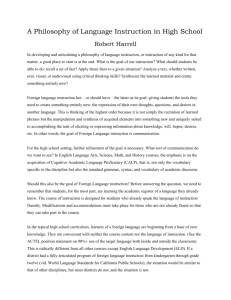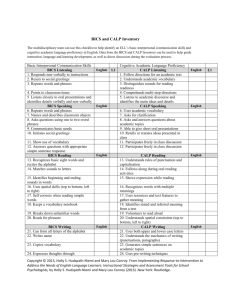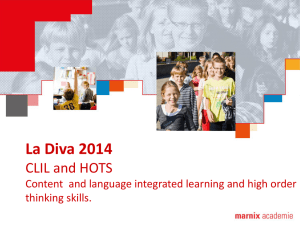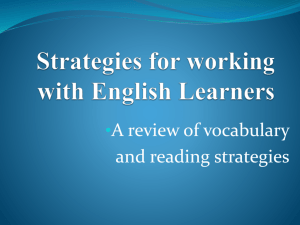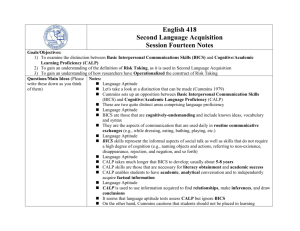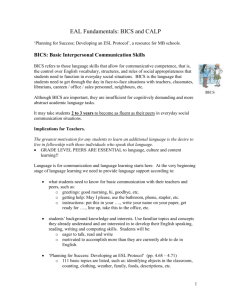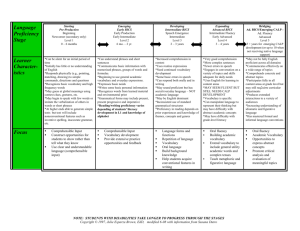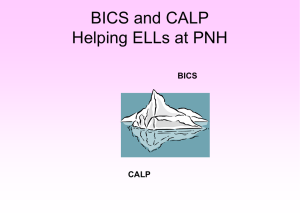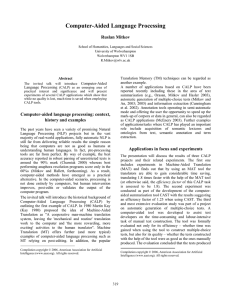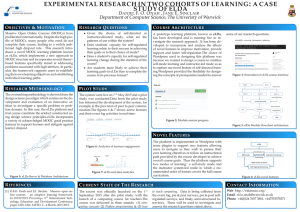Academic Language
advertisement
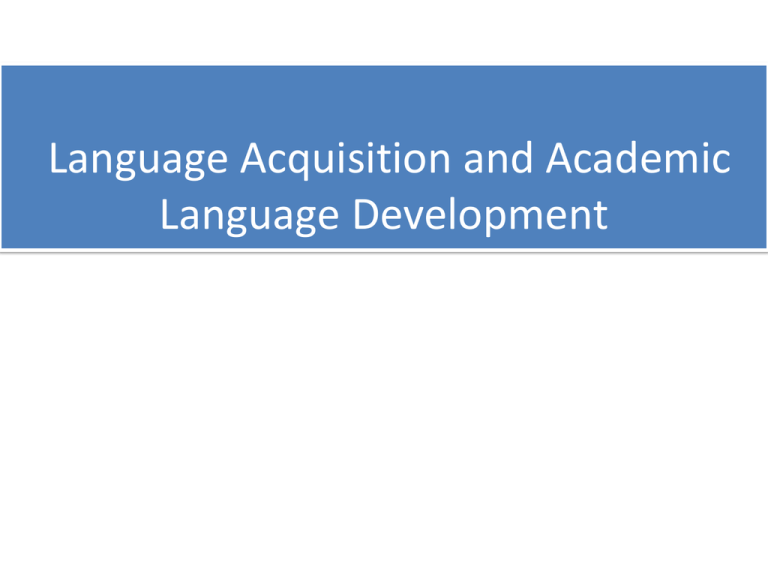
Language Acquisition and Academic Language Development Introduction: What do we know about English Language Learners (ELLs)? 9 One in ___public school students in K-12 comes from a home where a language other than English is spoken. In 1990 the figure was only 1 in 20, and by 2025 it 4 will be 1 in ___. 5 1990-2005: Increase from 2 to ___ million • This represents a 150% increase • General K-12 increase was 20% • Greatest growth states: SC, NC, TN, GA, IN---400% increase in ELLs 5 and ___ 7 years to learn English. It takes between __ What do the following acronyms stand for? • EL, ELL, LEP Think of your own experience of learning another language (or ask someone who has): • When did you learn it? • Where did you learn it? • How did you learn it? Or who taught you? • How well did you learn to read, write, speak, and listen? • What factors influenced your second language learning? • What do you think could have helped you master another language? Factors that Affect Second Language Acquisition • Language • • • • language distance level and type of L1 proficiency previous experience and knowledge of L2 L1 status • Learner (Internal) o o o o motivation and attitude age personality disabilities • Learning process (external) – Access to the language – Quality of instruction Stages of Language Acquisition Stage (ELDA -1) Preproduction (ELDA -2) Early Production Characteristics Student Time Frame • Has minimal comprehension 0–6 months • Teacher Prompts Show me…Circle the... Does not verbalize Where is...? • Nods “Yes” and “No” Who has...? • Has limited comprehension Yes/no questions • Produces one- or two-word responses Either/or questions • Participates using key words and familiar phrases One- or two-word answers Lists, Labels Why...? How...? (Source: Adapted from Krashen and Terrell (1983) 6 months–1 year • Has good comprehension • Can produce simple sentences Explain... • Makes grammar and pronunciation errors Phrase or short-sentence answers (ELDA 3-4) Intermediate Fluency • Has excellent comprehension What would happen if...? • Makes few grammatical errors Why do you think...? (ELDA 4-5) Advanced Fluency •The student has a near-native level of speech. Decide if... Retell... (ELDA 2-3) Speech Emergence 1–3 years 3–5 years 5–7 years Academic Language: Activating Prior Knowledge K-W-L-H • Think about and write the following: What do you know about Academic Language (AL) What do you want to know about AL • Pair with a neighbor. • Share your responses. Defining Academic Language Conversational (everyday) Language Academic Language •BICS ( Basic Interpersonal Communication Skills) •“playground English” or “survival English. •CALP (Cognitive Academic Language Proficiency) •CALPS is the language ability required for academic achievement in a contextreduced environment •The language is embedded in a rich context. •Topics for discussion are not cognitively demanding. •Academic language is more cognitively demanding than social language •Often abstract •There are few clues as to the meaning of the communication apart from the words themselves. Everyday versus Academic Language Everyday versus Academic Language • T-chart • What are the differences between everyday language and Academic Language? Defining Academic Language Activity: Look at the iceberg diagram and match language skills from the slide onto either BICS or CALP section of the iceberg. Are these BICS or CALP? 1. 2. 3. 4. 5. 6. 7. 8. 9. A student asks permission to see the nurse. BICS A student describes what he or she did over the weekend during the circle time. BICS A student writes a paragraph comparing and contrasting a rectangle and a parallelogram. CALP A student is able to understand a movie about a futuristic event. CALP A student asks for clarification in Science class. CALP A student describes his or her favorite president. CALP A student evaluates which president is the best. CALP A student is able to understand a lecture on photosynthesis. CALP A student is able to write a letter of apology to another student. BICS WIDA Standards Framework Features of Academic Language Performance Definitions Standards Matrix Appendix 10 Activity: Translate the two sentences on your own. A. Meine Mutter ist intelligent. B. Wenn meine Mutter nicht intelligent wäre, würde ich traurig sein. Math Proficiency: Language of Math Math as a Language Word/ Phrase Level Semantics •Knowing definitions; •Connotations of words based on the context; •Ability to translate Sentence Level Syntax •Three is greater than “n”; •If “n” is greater than five, then… Discourse Level Mathematical Discourse •More extensive reading and writing; •Cognitively demanding; •Uses specific linguistic functions like: persuading, arguing, hypothesizing Math Vocabulary (Types of Words) • Contextual (Difficult vocabulary that describes the context of a problem) • Content (Math words and phrases) • Functional (Action Verbs) Aunt Alice and the Silver Coins Aunt Alice gave each of her three nieces a number of silver dollars equal to their ages. The youngest felt that this was unfair. They agreed to redistribute the money. The youngest would split half of her silver coins evenly with the other two sisters. The middle sister would then give each of the others 4 silver coins. Finally, the oldest was to split half of her dollars equally between the two younger sisters. After exchanging money, each girl had 16 silver dollars. How old are the sisters? Discuss these questions: What is a content objective? What is a language objective? What is the purpose of having language and content objectives? What should the relationship be between language and content objectives? Content and Language Objectives: Content Objectives: • Know / Do – Concepts and/or skills – For ELLs • Focus on essentials • Simplify wording not content • Chunk Language Objectives: • Show – Using academic language • Receptively (L then R) • Expressively (S then W) – For ELLs • Scaffold support – Sentence frames “An estuary has _______ water, but an ocean has _______ water.” Analysis of language • What language does the student need to…? Forms and Conventions: Future tense (e.g., I predict the ice will melt…” Make predictions on states of matter with a partner. Vocabulary Usage: Liquid, solid, gas, states of matter Linguistic Complexity: Uses expanded clauses (e.g., I predict the ice will melt when exposed…” Sample language objectives • Students will use the future tense to make predictions of change in states of matter. • Students will produce expanded sentences using clauses to make predictions of change in states of matter. Let’s practice! Write a language objective for your ESOL students for your next class. Decide what key vocabulary, concept words, and other academic words Consider the language functions related to the topic of the lesson (e.g, will the students describe, explain, compare, or chart information)
